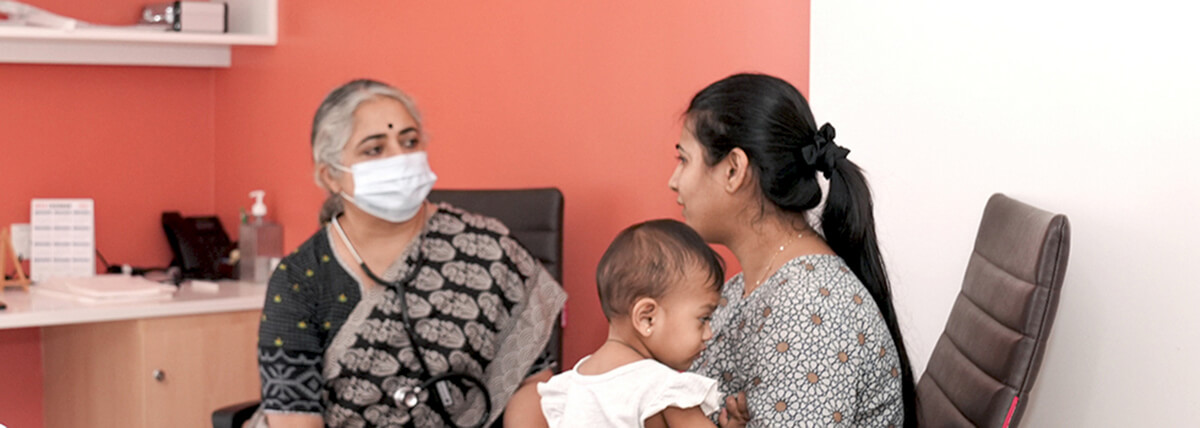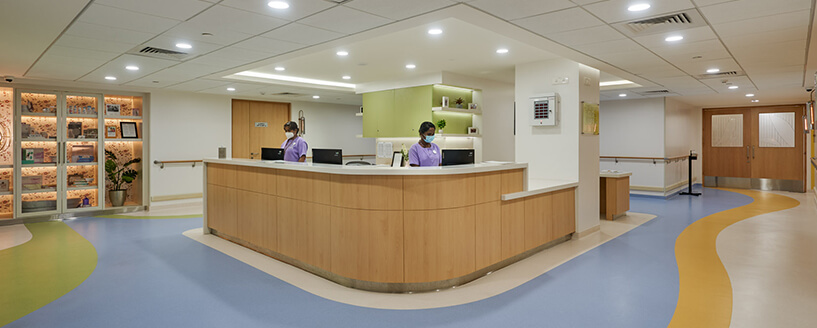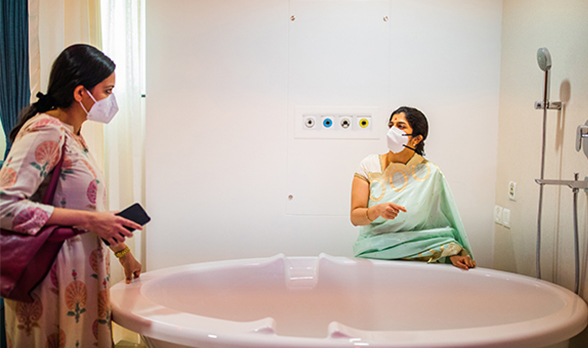NORMAL VAGINAL DELIVERY AND VAGINAL BIRTH AFTER CAESAREAN (VBAC)
Explore a vaginal birth delivery or a vaginal birth after a caesarean (VBAC) with our expert healthcare team

Aastrika Midwifery Centre aspires to be a place where mothers feel safe, supported, and empowered, and can experience joyful birthing surrounded by a caring, compassionate team.
- WHy Vaginal Birth
- AAstrika Support
- APPOINTMENT
- FAQs
VAGINAL BIRTH AND VAGINAL BIRTH AFTER CAESAREAN
At Aastrika Midwifery Centre, we promote physiologic or normal delivery and extensively support women throughout pregnancy and labour to achieve this. With a vaginal birth or normal delivery, the new mother can recover quickly and enjoy her journey into
motherhood to the fullest.
We support vaginal birth delivery for first time mothers, mothers with previous vaginal births, and also second time mothers seeking a VBAC delivery. A VBAC delivery refers to a vaginal birth after a caesarean section. Under the care of an experienced team, with the right support and advice, women who have had their earlier birth through a caesarean section also have the option to have a vaginal delivery with their subsequent births.
WHY DOES AASTRIKA SUPPORT VAGINAL BIRTH AND NORMAL DELIVERY?
Vaginal births have several benefits for both the mother and baby.
Postpartum recovery is much quicker and easier, with a shorter hospital stay post a vaginal birth delivery, as opposed to a caesarean. Quicker recovery of the mother ensures that she can spend more joyful time bonding with her new baby.
A normal vaginal delivery also avoids the risks of a c-section. In cases of true need, a c-section can be life saving for the mother or the baby. However, a caesarean delivery is a major abdominal surgery, with certain risks and side effects. A c-section can lead to complications such as infection, excess bleeding, adhesions of abdominal organs, and injury to other organs. A c-section delivery increases the risk in future pregnancies of uterine rupture, scar weakness, stillbirth, and dangerous complications like placenta previa and placenta accreta. Thus at Aastrika Midwifery Centre, a caesarean is only performed if a vaginal birth delivery is absolutely not possible.
Vaginal births support immediate skin to skin contact.
Vaginal births make it easier to ensure immediate, abundant, and continuous skin to skin contact and breastfeeding within one hour of birth. In this Golden Hour, babies are alert and ready to bond with their parents. Immediate skin to skin contact promotes attachment between the mother and the baby and provides a sense of safety to the baby. In such an environment, babies have a natural instinct to latch and start instinctively nursing, which is the ideal start to a smooth breastfeeding relationship.
The time spent with the mother immediately after birth aids in the adaptation of the baby to the new environment. It helps regulate the baby’s nervous system and body temperature. During vaginal delivery the baby passes through the birth canal and picks up bacteria which is beneficial in building a strong immune system.
HOW DOES AASTRIKA SUPPORT VAGINAL BIRTH AND VAGINAL BIRTH AFTER CAESAREAN (VBAC)?

evidence-based guidelines
Aastrika Midwifery Centre implements the latest evidence-based guidelines and ethical practices in maternity care. Our team of ethical doctors follow international evidence-based guidelines for when to intervene, such as when to induce or augment labour, and when to do a c-section. By strictly adhering to guidelines, we ensure that any medical intervention is only done if it is truly going to benefit the mother and baby, and otherwise, we carefully monitor the mother and baby while allowing the labour to progress spontaneously and lead to a normal vaginal delivery.
midwifery model of care
We follow a midwifery model of care, wherein we focus on non-medical interventions to help labour progress. Our healthcare team is well trained and experienced in using midwifery tools to support women through labour and delivery. At Aastrika Midwifery Centre, we encourage the mother to walk around during labour and do exercises using the birth ball, birth stool, and birth ropes which aid in the natural progression of labour. We have water birth pools and use water immersion during labour to provide pain relief and relaxation. We also have the signature Sensory Birthing Suite, which provides a calm and soothing environment for the mother-to-be, which may especially be beneficial for a woman trying for a VBAC delivery.
extensive VBAC support
For a Vaginal Birth After Caesarean or VBAC delivery, we provide the same extensive labour support. In addition, we carefully monitor for any complications arising from the previous c-section. We consider all details of the previous c-section to ensure that the mother-to-be is eligible for a VBAC delivery. Our team is also prepared to provide additional emotional and mental support for the mother. We encourage our VBAC delivery mothers to consider hiring a doula.
FAQ’s
Vaginal deliveries have several benefits for the woman and baby. It reduces the time spent at the healthcare facility post-birth, and also ensures a quicker recovery for the mother. It also allows for increased bonding between the mother and the baby by ensuring abundant immediate skin to skin contact and breastfeeding in the first one hour of birth. A normal vaginal delivery also helps build the baby’s immunity, and is safer for future pregnancies.
Some common ways to prepare for normal vaginal delivery include practising breathing exercises, walking or swimming, light exercise or prenatal yoga. Some women may choose to attend childbirth education classes where they learn about the process of birth, and which may also include information about the emotional, hormonal and physiological changes that a woman undergoes during pregnancy and labour.
At Aastrika Midwifery Centre, our interdisciplinary team of doctors, nurses, and midwives will work with the mother-to-be to develop customized plans on preparing for normal vaginal birth. We strongly encourage a healthy diet, routine exercise, and childbirth-specific exercises such as kegels and perineal massage.
There are three broad stages in the process of normal vaginal delivery. These are;
- Early and Active Labour- This stage begins when the regular contractions lead to the dilation of the cervix upto 10 cm. During early labour, the cervix opens and thins. The contractions during this stage are mild. During this stage, the mother may go for a walk or take a warm shower in order to relax. During active labour, the cervix dilates from 6-10 cm and the contractions tend to be more frequent and powerful.
- Pushing and Delivery of the baby- This begins when the cervix is completely dilated. The mother pushes with each contraction.
- Delivery of the placenta- After the child is born, the final stage is the delivery of the placenta. The mother may still have mild contractions.
At Aastrika Midwifery Centre, our healthcare team will support and guide the woman through all these stages and provide non-pharmacological methods to ease pain and enhance comfort.
Vaginal birth delivery is one where a woman births the baby through her vagina. There can be different types of vaginal births, as described below:
- Spontaneous Vaginal Birth: A spontaneous vaginal birth is when the mother naturally pushes the baby out, without any intervention. This type of vaginal delivery has the least side effects and the quickest recovery time for the mother. Sometimes, there may be a small natural tear, which is repaired by the doctor, and usually heals quickly.
- Forceps Delivery: this is when the woman births through the vagina, and forceps need to be used to pull the baby out, as the baby is not progressing through the birth canal even after the mother pushes.
- Vaginal Delivery with an Episiotomy: An episiotomy is a cut made at the end of the vaginal opening in order to enlarge the opening. Routine use of episiotomies, during births, are not recommended. An episiotomy should be conducted only when medically necessary.
- Vacuum Extraction Delivery: In this method, a vacuum extractor is used to pull the baby. It is similar to a forceps delivery, but instead of forceps, a vacuum extractor is used.
Women can and do have spontaneous vaginal deliveries without any of the above mentioned three procedures. At Aastrika Midwifery Centre, we promote spontaneous vaginal birth delivery without the use of any interventions, unless absolutely necessary. We use a range of methods to protect the perineum and prevent tearing.
In order to prepare for a Vaginal Birth after C-section or VBAC delivery, it is important to learn about vaginal delivery. Childbirth education classes are strongly recommended. It is essential to find a doctor or care provider who shares the same ideas as you and is patient and supportive. It is important to prepare your mind as well as your body for a vaginal delivery. In addition to the regular preparation for a vaginal birth delivery, mothers can discuss the reasons for their previous c-section with their healthcare provider, and incorporate individual-specific preparations for their VBAC delivery.
A c-section can lead to complications such as infection, excess bleeding, adhesions of abdominal organs, and injury to other organs.
A repeated c-section further increases the chances of excess bleeding, and further increases the risks in future pregnancies of uterine rupture, stillbirth, and dangerous complications like placenta previa and placenta accreta which can lead to severe bleeding in delivery and long term morbidity.
Also see…


